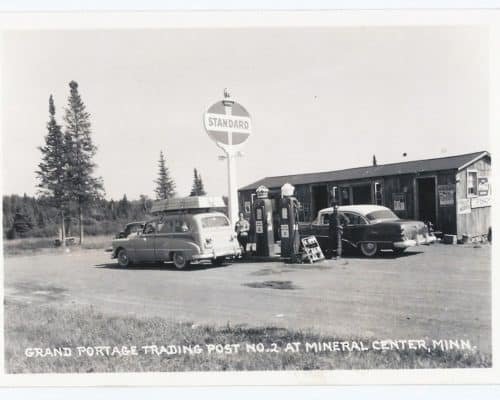Mineral Center, Cook County Minnesota
 Before the logging rush of the 1940s, the area experienced the Mineral Rush at the turn of the century. In the 1880s and 1890s settlers were attracted to the areas along Lake Superior’s shoreline. The communities now known as French River and Knife River were developed during this time. Then, the passage of the Nelson Act in 1889 opened up areas of the Grand Portage Indian Reservation to white settlers. The Mineral Rush moved north. One of the most well-known settlements that were born during the mineral rush along the North Shore was Mineral Center.
Before the logging rush of the 1940s, the area experienced the Mineral Rush at the turn of the century. In the 1880s and 1890s settlers were attracted to the areas along Lake Superior’s shoreline. The communities now known as French River and Knife River were developed during this time. Then, the passage of the Nelson Act in 1889 opened up areas of the Grand Portage Indian Reservation to white settlers. The Mineral Rush moved north. One of the most well-known settlements that were born during the mineral rush along the North Shore was Mineral Center.
The Creation of Mineral Center
In 1909 Malcolm Linnell visited the area with family members from Black River Falls, Wisconsin. They came to see if the rumors of mineral deposits and rivers full of fish amongst the vast wilderness were true. What they found was even greater than what they had expected! And so, when they passed through Duluth on their way back to Wisconsin, they filed their homestead claim on an area about 15 miles inland from Hovland.
By 1910 the first settlers who would eventually call Mineral Center home arrived in Hovland. This first group started building their homestead on the Linnell homestead claim. Despite some hardships early on- including wildfires that destroyed much of the surrounder area in 1913, Mineral Center survived and thrived. Eventually, it would reach a population of around 350 by 1930. The town would grow to have a post office, a general store, three schools, a church, and a cemetery.
Interestingly, it was tourism that helped Mineral Center thrive. Visitors from Minneapolis and St. Paul would come up to experience a week in the wilderness- hunting for white-tailed deer, getting a ride on an ox-pulled cart, and hauling water from a nearby spring. Souvenir stands lined the main road where native artisans would sell jewelry, blankets, and other goods.
Mineral Center Becomes a Ghost Town
Mineral Center’s eventual demise didn’t come as the result of natural resources drying up. They didn’t lose their primary industry and jobs the way other towns in the area had. Instead, the town became a ghost town due to the Federal Government purchasing the homesteads back and returning them to the Grand Portage Tribe in 1940.
Eventually, the buildings and homes in Mineral Center were moved to other communities or dismantled for scrap wood. But not all was lost- the cemetery was preserved and in 2010 a renovation was undertaken to ensure the cemetery would remain and the area still open to visitors.
Learn More About Mineral Center
If you want to learn more about this ghost town, watch Mineral Center: Passport Into the Past by the Cook County Historical Society.
Getting There
Take Highway 61 and turn onto Co Rd 89/Old Highway 61 a few miles north of Hovland, MN. Stay on Old Highway 61 for 6.3 miles until the intersection of Old Highway 61 and Co Rd 17/Mineral Center Road. The town and cemetery are located near this intersection on the Grand Portage Reservation. While these are maintained roads, they can be difficult to pass in poor weather. Please use caution and be aware of your route ahead of time. A four-wheel-drive vehicle is recommended.
Mineral Center photos courtesy of the Cook County Historical Society
Listen to Joe and Jaye explore and discuss Ghost Towns on the Exploring the North Shore Podcast:
